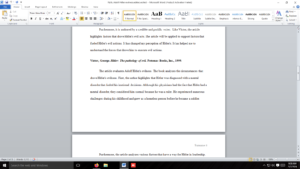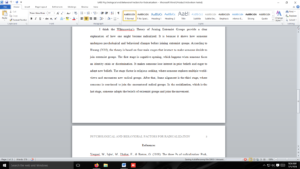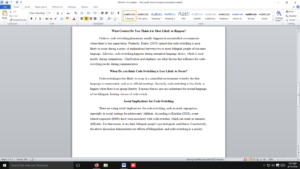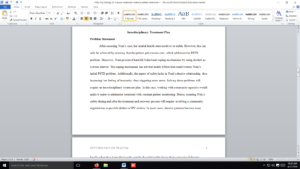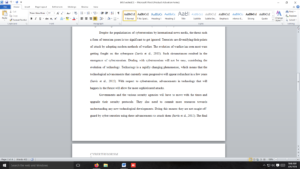Each student will select a question (problem) associated with human behavior and examine different explanations for the behavior. (Examples: Why are some people evil? Why are more children diagnosed with ADHD or Autism now than previously? Why do people lie? Why do people XYZ? What causes XYZ in humans? How does XYZ behavior in humans develop?)
Each student will a) research, b) analyze possible explanations, and c) evaluate answers to his/her question using at least two prominent psychological theoretical perspectives that we have studied in this course: biological, evolutionary, cognitive, behavioral, psychodynamic, sociocultural, and humanistic. The student will also form conclusions about which psychological perspective best explains the identified problem and address ethical issues associated with the problem.
The student will document the information in the form of an essay (4-5 pages) using APA style. The essay will be submitted through the assignment link on the course Blackboard site.
Steps to assignment completion:
- Statement of the problem: Identify and explain your question of interest regarding human behavior. Why is this of interest to you? Why is this question important? Why is this behavior considered a problem (include supporting data)?
- Evidence: Select (and thoroughly describe) two prominent psychological theoretical perspectives which address the problems.
After describing the psychological perspectives, research and identify one source for each perspective (total: 2 sources) which address the question. List and summarize each of the sources. These sources should be written by professionals who have expertise in the subject.
- Influence of Contexts and Assumptions: Using the information from these sources, thoroughly explain how a psychologist working within each perspective views the problem, and how she or he would try to answer the question. (IN-TEXT CITATIONS AND REFERENCE PAGE ARE TO BE COMPLETED IN APA STYLE.)
- Student’s Position: Evaluate the information you’ve described and form personal conclusions. Explain why you agree with one perspective over the other or offer an alternative psychological perspective as the explanation. You must select only one perspective and support your position with evidence. How do your conclusions impact you? Why are your conclusions important for you?
- Conclusions and Related Outcomes: Expand beyond your personal conclusions and further evaluate the information. What implications or impact do your conclusions have for psychologists and society at large? For example, do your conclusions suggest different areas for psychologists to investigate or study? Could what you have concluded be used to help society at large, or do your conclusions suggest dangers or warnings for society? What might be the economic, political, social, or educational implications of what you’ve concluded?
- Ethical Considerations: Psychologists often encounter ethical issues/concerns when addressing human problems. Using the 8 key ethical questions as presented by James Madison University (fairness, outcomes, responsibility, character, liberty, empathy, authority, and rights) think about the ethical issues that may result from the problem you have identified. Select at least 3 of the most appropriate questions and explain how each applies to your selected problem about human behavior. (The questions provided below are examples of possible ethical issues/concerns associated with depression.)
Fairness– How can I act equitably and balance legitimate interests? What if I am unable to care for my family and continue my employment? Do I have to reveal my illness to my employer?
Outcomes – What achieves the best short- and long-term outcomes for me and all others? What happens if I get treatment for my depression? What if I choose not to accept treatment? How does the treatment or lack of treatment impact my family, friends, and coworkers? Will the depression eventually go away? Are there advantages to getting treatment sooner rather than later? What types of treatment seems to work best?
Responsibilities – What duties and/or obligations apply? Even though my friend/family member has not admitted directly to me they are suicidal, should I contact a professional if I suspect someone is suicidal? What professional should I contact?
Character – What action best reflects who I am and the person I want to become? Those who suffer from depression experience many negative symptoms; irritability, lack of interest, intense sadness, confusion, fatigue, sleep difficulties, thoughts of suicide, etc. Could depression impact who a person becomes? Can depression influence relationships at home, school, or work? Does depression own the sufferer or can the sufferer learn to own the depression?
Liberty – How does respect for freedom, personal autonomy, or consent apply? Can those who experience severe depression be forced to seek help and receive treatment for depression? What should I do if someone confides they are suffering from depression? Should I call someone? Who do I call? Is my call confidential?
Empathy – What would I do if I cared deeply about those involved?Would I want to see those I care about suffer from the negative symptoms of depression? How can I help since I am not a therapist?
Authority – What do legitimate authorities (e.g. experts, law, my religion/god) expect of me? Can I be forced into treatment? Will my parents/family support me getting help?
Rights – What rights (e.g. innate, legal, social) apply? Should insurance companies be required to cover mental health services? Should counseling centers be required to provide services to individuals who do not have insurance or available funds?
After you have written your essay (4-5 pages) in APA style, save it as a WORD or PDF file and submit through the Critical Thinking Assignment Link on Blackboard. In addition to content, students will be graded on preparation and planning, APA formatting, written product, level of engagement, and overall attitude. Refer to the GRADING rubric for specific
